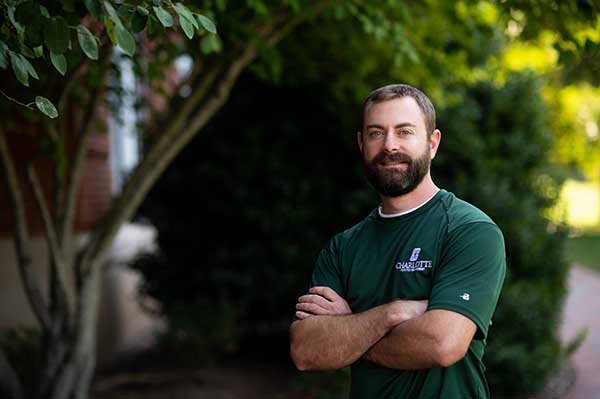Campus arborist Brad Caudle oversees tree care

Brad Caudle, a certified arborist through the International Society of Arboriculture, oversees tree care and maintenance throughout the developed portion of campus. Learn more about his role and how and why trees alter in the fall.
What is the most practical way to describe what you do?
The field of arboriculture is a rapidly evolving profession that uses the latest technology and data to provide care for trees. A forestry professional (silviculturist) studies large stands of trees. An arborist, by comparison, works on individual trees in urban settings. On a daily basis, I am looking to stay ahead of potential issues before they become hazards or a nuisance. A good arborist will care for trees on a proactive basis compared to a reactive one. Proper tree pruning, for example, helps to improve the structural integrity and health of each species.
In your time at the University, how have you seen the campus tree canopy change? How have you been part of that?
I have been working in this role for about four years now. Although trees are long-lived and often slow-growing, I have noticed many areas of change. One area, in particular, is along both sides of Johnson Alumni Way (just above Cameron Blvd). There were trees planted as a reforestation initiative in this area before I arrived. This effort was led by some of our grounds staff in facilities management and student volunteers. I have been out periodically to provide pruning and staking to a few along the way. These plantings have really taken off, and this area is beginning to fill in quite nicely.
Are there any new projects you’re working on in the next few months that may be of interest to the campus community?
I recently worked on an online resource that will allow people to view our tree inventory database. This database will show you the exact location of each of the tree species we have planted on campus. Think of it as a bird’s-eye view of the campus with little green dots that represent each tree. If you are interested in knowing which species of tree might be in your yard, you can use this information to help you identify what that tree could be. Perhaps you might go out for a walk on campus during the fall and pick out your favorite trees. Just click on the little green dots and you can view information about each of the many species.
How will we see the campus tree canopy transform this fall?
Look for a wave of color to move through our area beginning in November. As we get closer to the middle of the month, I anticipate seeing many of our deciduous trees putting on a nice show. Last year, the most beautiful colors on campus could be found in the following tree species:
- Persimmon – Bright orange
- Hickory – Bright yellow
- Sugar Maple – Varying from yellow to orange and red
- Sweet Gum – Deep crimson red
- Black Gum/Tupelo – Bright red
Are there any facts we should know about trees and how they change in the fall?
The short answer is that as the season changes, the days begin getting shorter. Shorter days mean less sunlight and this signals the tree to prepare for a long winter nap. Weather is also an important factor in the change. When the temperatures begin to dip, you will begin seeing the transformation, as the leaves begin to manufacture fewer photosynthates and the chlorophyll (green pigments) in the chloroplasts begin to fade. As the process ensues, the vivid colors begin to show in our deciduous trees. After the chlorophyll fades, anthocyanins (responsible for the red pigment), xanthophylls (yellow pigments) and carotenoids (orange pigments) are the true color of the leaves! Once the trees have put on a show for us visually, the leaves slowly begin to fall — or senesce, if you want to sound intelligent. Lastly, the trees begin to prepare for the colder season of winter and no longer need to keep leaves during this dormant period.
What are your previous experiences in the field?
I am originally from Charlotte and have worked in the tree care industry for the last 11 years. I became a certified arborist through the International Society of Arboriculture about nine years ago. My previous experience within the tree care industry has been with Arborguard Tree Specialists and the Davey Tree Expert Company. I got my first opportunity to enter the green industry while working for Scotts Miracle-Gro Company. I am excited to say that I have recently received funding and have been accepted to sit for the exam to become a board-certified master arborist.
What do you enjoy doing outside of work?
In addition to my day job, I am reaching completion of a bachelor’s degree in biology/environmental science at UNC Charlotte. I really appreciate the support from my department to accomplish this milestone in my journey. When I do have some spare time, I enjoy listening to live music and dining out with family and friends. I also enjoy the thrill of fishing. I hope to someday travel the globe and add to the list of species. It would also be fun to see as many national parks along the way.